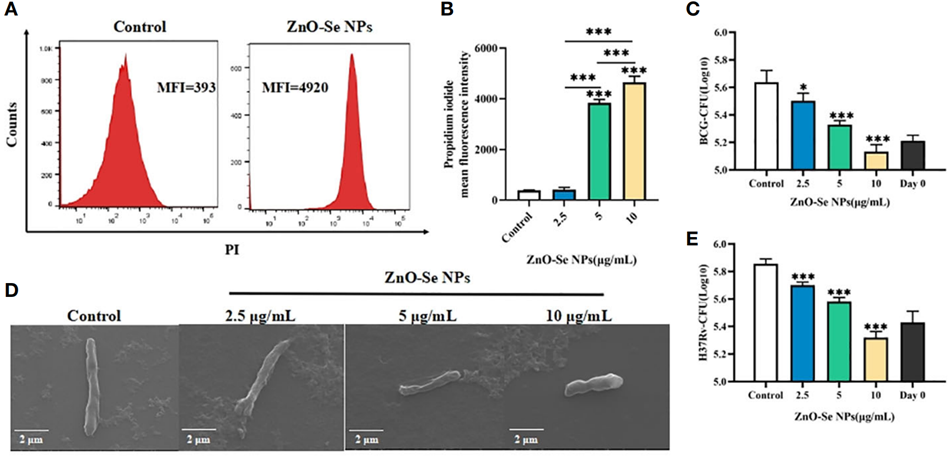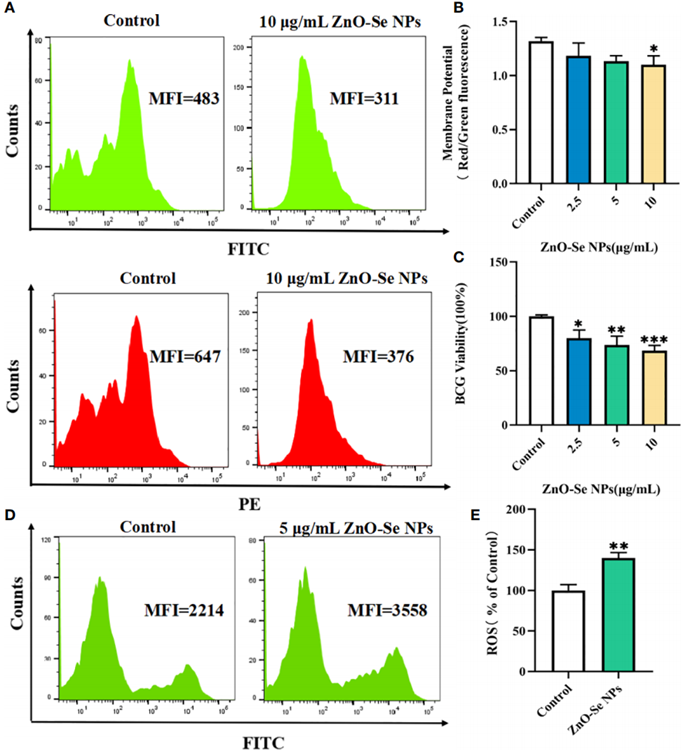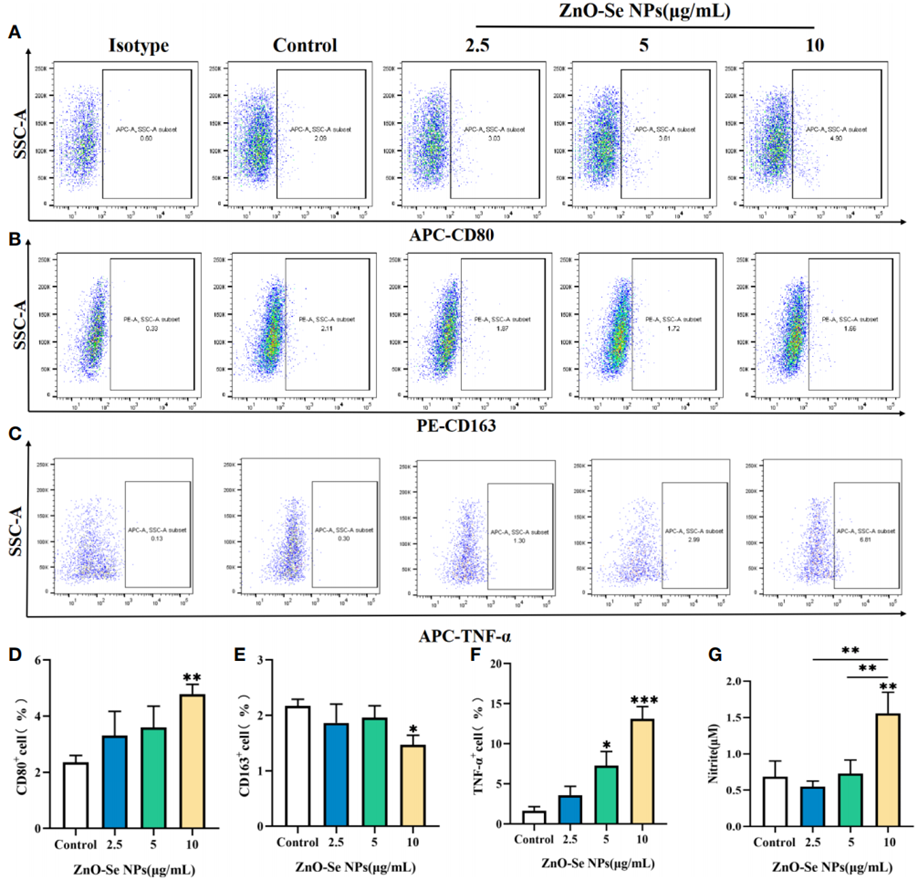Editor: Tiffany
Researchers have developed zinc oxide hybrid selenium nanoparticles that effectively target Mycobacterium tuberculosis, enhancing both bacterial killing and host immune responses.
Key Highlights
- Research Question:
Can zinc oxide hybrid selenium nanoparticles effectively combat Mycobacterium tuberculosis while enhancing host cell immune responses? - Research Difficulties:
Traditional antibiotics have low intracellular killing efficiency, leading to prolonged therapy, side effects, and drug-resistant strains. - Key Findings:
The zinc oxide-selenium nanoparticles (ZnO-Se NPs) showed strong bactericidal effects against both extracellular and intracellular M. tuberculosis, promoting immune cell polarization and apoptosis. - Innovative Aspects:
The study introduces a novel hybrid nanoparticle formulation that synergizes the anti-tuberculosis effects of zinc oxide and selenium, targeting both the bacteria and host immune mechanisms. - Importance of the Study:
This research offers a promising new approach for tuberculosis treatment, addressing significant limitations of current antibiotic therapies and potentially reducing the development of drug-resistant mutants.
Investigating Tuberculosis and Limitations of Current Treatments
Tuberculosis (TB) is a severe infectious disease caused by the bacterium Mycobacterium tuberculosis (Mtb). It predominantly affects the lungs but can also target other organs. As a major global health concern, TB ranks among the leading causes of death from infectious diseases, particularly in developing nations. According to the World Health Organization, approximately 10 million new cases and 1.5 million TB-related deaths were reported in 2020. The disease spreads through airborne transmission when an infected individual coughs or sneezes, contributing to its high contagiousness. Symptoms typically include a persistent cough, chest pain, hemoptysis (coughing up blood), fatigue, unintended weight loss, fever, and night sweats.
Current TB treatments rely on a regimen of antibiotics, including rifampicin, ethambutol, and isoniazid, administered over an extended period, often exceeding six months. This prolonged duration frequently results in adverse side effects and poor patient adherence, complicating disease management. Moreover, the extensive use of these antibiotics has fueled the emergence of drug-resistant TB strains, rendering conventional therapies less effective. These challenges underscore the critical need for innovative treatment approaches that can enhance efficacy, reduce side effects, and address the growing threat of drug resistance.
Objectives of the Novel Nanoparticle Approach
A research team from Guangdong Medical University in China set out to explore a novel therapeutic strategy for TB using nanotechnology. Their study, published in January 2023 in Frontiers in Cellular and Infection Microbiology, focused on developing nanoparticles composed of zinc oxide and selenium, termed ZnO-Se NPs. The primary aim was to investigate whether these nanoparticles could serve as an effective anti-TB agent by directly targeting the bacteria and enhancing the host immune response.
The researchers outlined three key objectives:
- Synthesis and Characterization: To create and analyze the physical properties of ZnO-Se NPs.
- Antibacterial Efficacy: To assess the nanoparticles’ ability to eliminate TB bacteria both extracellularly and within human cells.
- Immune Modulation: To examine how ZnO-Se NPs influence the immune response in TB-infected cells.
The motivation stemmed from the limitations of existing treatments, particularly the ability of Mtb to persist within host cells, evading antibiotics, and the prolonged treatment regimens that contribute to drug resistance. The team hypothesized that ZnO-Se NPs could offer a dual mechanism—directly killing bacteria and boosting immunity—potentially overcoming these obstacles and paving the way for more efficient TB management.
Experimental Design and Key Findings
(1) Experimental Process Outline
- Preparation of zinc oxide-selenium nanoparticles (ZnO-Se NPs) through hybridization.
- Characterization of ZnO-Se NPs via dynamic laser light scattering (DLS) and transmission electron microscopy (TEM).
- Evaluation of the inhibition effects of ZnO-Se NPs on extracellular Mycobacterium tuberculosis (Mtb) using colony-forming units (CFU) counting.
- Analysis of bacterial ATP production, membrane potential, and scanning electron microscopy imaging.
- Assessment of the effects of ZnO-Se NPs on reactive oxygen species (ROS) production, mitochondrial membrane potential, apoptosis, autophagy, and macrophage polarization in infected THP-1 cells.
- Examination of the intracellular growth inhibition of Mtb in THP-1 cells treated with ZnO-Se NPs using CFU counting.
(2) Key Experiments
1. Evaluation of Extracellular Mtb Inhibition by ZnO-Se NPs
- Procedure:
- 4×10^5 colony-forming units (CFU) of BCG suspension were incubated with various concentrations of ZnO-Se NPs in 7H9 medium at 37 °C for 72 hours.
- The suspension was diluted and plated on Middlebrook 7H11 plates for CFU counting after 3-4 weeks.
- Result:
- The CFU counts indicated that ZnO-Se NPs significantly inhibited BCG growth at non-cytotoxic concentrations. The treated group at 10 mg/mL exhibited lower CFU counts than the Day 0 control.
- Finding:
- ZnO-Se NPs demonstrated strong bactericidal effects against extracellular Mtb, indicating their potential as effective anti-TB agents.

Figure 1. Killing/inhibition effects of ZnO-Se NPs against Mtb.
2. Impact on Membrane Integrity and ATP Production
- Procedure:
- BCG was treated with 10 mg/mL ZnO-Se NPs, and membrane potential was analyzed using the DIOC2(3) dye to assess membrane integrity.
- ATP production was measured using the BacTiter-Glo microbial cell viability assay.
- Result:
- Treatment with ZnO-Se NPs resulted in a significant disruption of membrane integrity, as evidenced by changes in membrane potential. There was also a marked decrease in intracellular ATP levels.
- Finding:
- The ability of ZnO-Se NPs to impair membrane integrity and reduce ATP production contributes to their bactericidal efficacy against Mtb.

Figure 2. Killing/inhibition mechanisms of ZnO-Se NPs against Mtb.
3. Effects on Macrophage Polarization and Cytokine Production
- Procedure:
- THP-1 macrophages were infected with BCG, and then treated with ZnO-Se NPs. The expression of M1 (CD80) and M2 (CD163) markers was analyzed by flow cytometry, alongside the measurement of TNF-a levels.
- Result:
- ZnO-Se NPs significantly increased CD80 expression while decreasing CD163 expression in BCG-infected macrophages. Additionally, TNF-a production was notably elevated in treated cells.
- Finding:
- ZnO-Se NPs promote M1 polarization in macrophages, enhancing pro-inflammatory cytokine production, which is crucial for effective anti-mycobacterial activity.

Figure 3. Effects of ZnO-Se NPs on the polarization of Mtb infected macrophages.
These key experiments highlight the multifaceted mechanisms through which ZnO-Se NPs exert their anti-tuberculosis effects, supporting their potential as novel therapeutic agents.
Implications for Future Tuberculosis Treatments
The research from Guangdong Medical University presents ZnO-Se nanoparticles as a promising advancement in TB treatment. The study revealed that these nanoparticles effectively kill Mtb strains BCG and H37Rv outside cells by disrupting essential bacterial functions. Inside human macrophages, they reduced bacterial loads while simultaneously enhancing immune responses through M1 polarization and increased production of antimicrobial substances like nitric oxide, TNF-α, and IFN-γ. Additionally, the induction of apoptosis and autophagy in infected cells further aids in eliminating intracellular bacteria.
This dual-action mechanism—direct antibacterial activity paired with immune enhancement—distinguishes ZnO-Se NPs as a potential alternative to traditional antibiotics. Such an approach could mitigate the challenges of lengthy treatment durations and drug resistance, offering hope for improved TB management. The researchers propose that ZnO-Se NPs could be developed into a novel therapeutic agent, with future studies needed to refine their formulation, assess safety in vivo, and validate efficacy in clinical settings. This work underscores the transformative potential of nanotechnology in addressing infectious diseases that continue to burden global health systems.
Reference:
Lin, Wensen, et al. “Engineering zinc oxide hybrid selenium nanoparticles for synergetic anti-tuberculosis treatment by combining Mycobacterium tuberculosis killings and host cell immunological inhibition.” Frontiers in Cellular and Infection Microbiology 12 (2023): 1074533.
